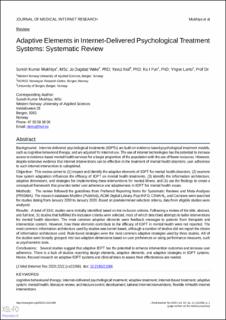| dc.description.abstract | Background: Internet-delivered psychological treatments (IDPTs) are built on evidence-based psychological treatment models, such as cognitive behavioral therapy, and are adjusted for internet use. The use of internet technologies has the potential to increase access to evidence-based mental health services for a larger proportion of the population with the use of fewer resources. However, despite extensive evidence that internet interventions can be effective in the treatment of mental health disorders, user adherence to such internet intervention is suboptimal. Objective: This review aimed to (1) inspect and identify the adaptive elements of IDPT for mental health disorders, (2) examine how system adaptation influences the efficacy of IDPT on mental health treatments, (3) identify the information architecture, adaptive dimensions, and strategies for implementing these interventions for mental illness, and (4) use the findings to create a conceptual framework that provides better user adherence and adaptiveness in IDPT for mental health issues. Methods: The review followed the guidelines from Preferred Reporting Items for Systematic Reviews and Meta-Analyses (PRISMA). The research databases Medline (PubMed), ACM Digital Library, PsycINFO, CINAHL, and Cochrane were searched for studies dating from January 2000 to January 2020. Based on predetermined selection criteria, data from eligible studies were analyzed. Results: A total of 3341 studies were initially identified based on the inclusion criteria. Following a review of the title, abstract, and full text, 31 studies that fulfilled the inclusion criteria were selected, most of which described attempts to tailor interventions for mental health disorders. The most common adaptive elements were feedback messages to patients from therapists and intervention content. However, how these elements contribute to the efficacy of IDPT in mental health were not reported. The most common information architecture used by studies was tunnel-based, although a number of studies did not report the choice of information architecture used. Rule-based strategies were the most common adaptive strategies used by these studies. All of the studies were broadly grouped into two adaptive dimensions based on user preferences or using performance measures, such as psychometric tests. Conclusions: Several studies suggest that adaptive IDPT has the potential to enhance intervention outcomes and increase user adherence. There is a lack of studies reporting design elements, adaptive elements, and adaptive strategies in IDPT systems. Hence, focused research on adaptive IDPT systems and clinical trials to assess their effectiveness are needed. | en_US |

